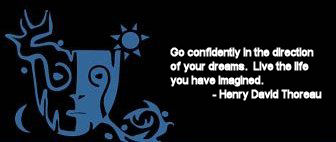|

The On-Going Quest
by Gary German
[Images: "White Buffalo Calf Woman" by Rogue Guirey Simpson; "Perceval and the Grail Meal" by A. Spiess; "Hear My Prayer of Peace, Understanding and Unity" by Dorothy Tidwell Sullivan;
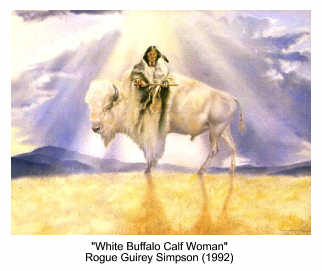 In the winter of 1984 I attended a class in Lakota Spirituality and Rituals. Stirred by the myth of White Buffalo Calf Woman, I was drawn to South Dakota to experience Lakota elders, spirituality and rituals. "You have lost your way and have come to find it", said the medicine man. I was then instructed to do a Vision Quest. A few weeks later I found myself in a sweat lodge being handed a round earthen made cup containing water. "Only one small sip," he told me. Water as symbol was explained as "... a gift of Great Spirit that gives life to all things and permeates all living beings." The next few days I was naked, without water or food, on a hill in an area encircled with prayer-ties which I had laboriously made. Prayer flags representing the Four Directions and Seasons were in place. The prayer-ties surround a round covered shelter symbolizing the womb of Mother Earth. The empty water vessel is placed at the entrance to the shelter to remind me what I am looking for. There in the womb of Great Mother, holding the bowl and stem of the Sacred Pipe, I am left alone to quest. In the winter of 1984 I attended a class in Lakota Spirituality and Rituals. Stirred by the myth of White Buffalo Calf Woman, I was drawn to South Dakota to experience Lakota elders, spirituality and rituals. "You have lost your way and have come to find it", said the medicine man. I was then instructed to do a Vision Quest. A few weeks later I found myself in a sweat lodge being handed a round earthen made cup containing water. "Only one small sip," he told me. Water as symbol was explained as "... a gift of Great Spirit that gives life to all things and permeates all living beings." The next few days I was naked, without water or food, on a hill in an area encircled with prayer-ties which I had laboriously made. Prayer flags representing the Four Directions and Seasons were in place. The prayer-ties surround a round covered shelter symbolizing the womb of Mother Earth. The empty water vessel is placed at the entrance to the shelter to remind me what I am looking for. There in the womb of Great Mother, holding the bowl and stem of the Sacred Pipe, I am left alone to quest.
Each prayer-tie is a prayer to a stone asking for protection and wisdom. The word for God among the Lakota is Wakan-Tanka meaning, The Holy Rock (Stolzman Pipe 47 and 60), implying the Oldest One or the Wisest One. The Lakota and many other Spiritual cultures have great respect for the earth and the use of stones. Stones as part of the sweat lodge ceremony are known to speak to the participants (47). One is reminded of the Philosopher's stone or Grail stone which is said to contain all secrets.
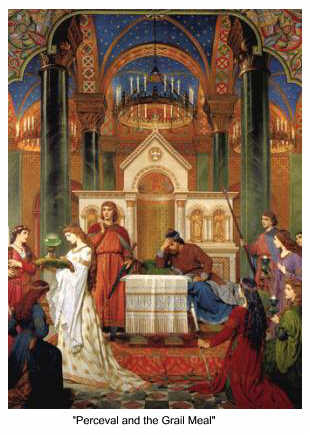 The Sacred Pipe, a bowl made of stone with a shaft, reminds me of the Grail and Lance of the twelfth century Grail legends. The Grail like the Sacred Pipe is held by those who earn the right to be in its presence. One is instructed to never leave the stem attached to the bowl unless at prayer, for when the two are together all thoughts in its presence will manifest. One is reminded of the Grail meal where each participant receives his desired thoughts (Loomis Celtic 58). The Grail like the Pipe has great power, and performs miracles at will. The Sacred Pipe, a bowl made of stone with a shaft, reminds me of the Grail and Lance of the twelfth century Grail legends. The Grail like the Sacred Pipe is held by those who earn the right to be in its presence. One is instructed to never leave the stem attached to the bowl unless at prayer, for when the two are together all thoughts in its presence will manifest. One is reminded of the Grail meal where each participant receives his desired thoughts (Loomis Celtic 58). The Grail like the Pipe has great power, and performs miracles at will.
Carl Jung says of the Grail,
"The bowl is a vessel that receives or contains, and is therefore female. It is a symbol of the body which contains the animal, the breath and liquid of life, while the dagger [the lance] has piercing penetrating qualities and is therefore male. It cuts, it discriminates and divides, and so is a symbol of the masculine Logos principle." (Jung, CW 18: 121)
He points out the central motif of Wagner's Parsifal as the reunion of the spear and the Grail. "This union is a symbol of complete fulfillment — eternity before and after the creation of the world, a dormant condition. That is probably the thing which the desire of man is seeking" (Jung, CW 18: 120). This union of the male and female powers within is likened to Paradise and reflects the way the Grail is handled or by whom it is seem (Matthews Grail 87).
Von Eschenbach recreates an image of paradise through a parade of twenty-four beautifully dressed maidens. "Following them came the fair Repanse de Schoye, a maiden most rare. By her alone, no other, I am
told, did the Grail let itself be carried" (Parzival 401). As if spell bound by her presence, all attending question the games and bonds of love they once knew (401-402). Who is this mysterious figure? Evans Lansing Smith says, "She is mother universe, from whose womb are born the 12 hours [maidens] of the night on her left, and twelve hours [maidens] of day on her right. She bears the sacred vessel of the Grail as a symbol of her own power, and she balances the male Trinity of the Grail Castle" (Sacred Mysteries 66).
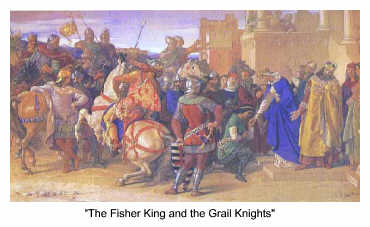 I am deeply moved by Professor Smith's symbolical description of Repanse de Schoye and the Fisher King's Castle, the surrounding setting, persons and objects. I find myself taken back to the moment of Vision Quest. The prayer flags representing the Four Directions and Seasons are noticed in the repeated theme of four. Smith says, "The entire castle is a magnificent mandala radiating around the Grail by the fire in the center, the still point of the turning world, surrounded by groups of four, which reiterate the mystical quaternity" (Smith Sacred Mysteries 67). The Grail reminds me of the bowl of the Sacred Pipe. The dome shaped tent at the site of Vision Quest represents the womb of the great mother. Both the Pipe and the Grail point to the divine feminine and are revealed at a time of influx of new cultures. I am deeply moved by Professor Smith's symbolical description of Repanse de Schoye and the Fisher King's Castle, the surrounding setting, persons and objects. I find myself taken back to the moment of Vision Quest. The prayer flags representing the Four Directions and Seasons are noticed in the repeated theme of four. Smith says, "The entire castle is a magnificent mandala radiating around the Grail by the fire in the center, the still point of the turning world, surrounded by groups of four, which reiterate the mystical quaternity" (Smith Sacred Mysteries 67). The Grail reminds me of the bowl of the Sacred Pipe. The dome shaped tent at the site of Vision Quest represents the womb of the great mother. Both the Pipe and the Grail point to the divine feminine and are revealed at a time of influx of new cultures.
The Grail manifests miracles during the meal, is untouchable and seen by a few. Feriefiz, an unbaptized, is encouraged by Anfortas "to note the people's sole source of nourishment and they explained that all infidels
were barred from seeing it" (Eschenbach Parzival 404). Those who believe, the baptized, experience the miraculous. "With ceremony they received from the Grail meats both wild and tame: for this man mead, for another wine, each according to his custom; mulberry wine, tinctured, clary" (Eschenbach Parzival 402). One understands why those who serve the Grail are unique. "They are a Grail company ... ready to serve and obey you in all things" (393). They seem taken hold of by divine zeal.
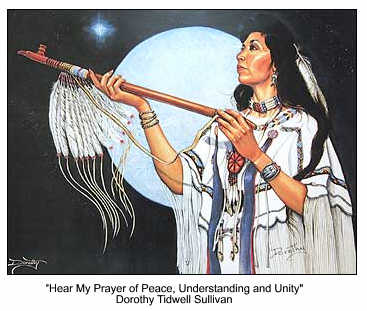 The urge that drew me from Chicago, Illinois to South Dakota to quest a vision was as great as any quest for the truly thirsty. I was a student in the Franciscan Order then. Everything around me was male or masculine: the hierarchical Church; the Order of Men; even the buildings I lived in. Taken hold by the quest, I found myself in the womb of the Great Mother. Holding the bowl and stem of the pipe (the prayers of the universe) I received a vision. This experience served to balance the male and female energies within me, which changed my life and outlook. The urge that drew me from Chicago, Illinois to South Dakota to quest a vision was as great as any quest for the truly thirsty. I was a student in the Franciscan Order then. Everything around me was male or masculine: the hierarchical Church; the Order of Men; even the buildings I lived in. Taken hold by the quest, I found myself in the womb of the Great Mother. Holding the bowl and stem of the pipe (the prayers of the universe) I received a vision. This experience served to balance the male and female energies within me, which changed my life and outlook.
The idea of the quest is as old as the human being. Stories of the Grail quest began in the early twelfth century (Matthews 5). It was presented as an object "worth giving up one's life to find, even in the
knowledge that the search may be fruitless" (5). The quest itself is "... a spiritual goal representing inner wholeness, union with the divine, self-fulfillment" (5). The main idea appears to be that one is on the journey; is seeking. While many set off in the task few seem successful; Gawain, Galahad, Perceval and Bors are some who actually encounter the Grail; the chosen few who overcome obstacles, whose rewards are good fortune, blessings, and union with the Divine (5).
The quest for the Grail is more than personal as the knights have vowed to honor the king and the kingdom. We are not on this planet for selfish means. As keeper of the Grail, the king is referred to as the Fisher King or Rich Fisher which symbolizes that he is "a provider of food in both the physical and spiritual senses" (Matthews 77). Referring to the Fisher King, Carl Jung speaks of the fish as a well known symbol of Christ (122) and
...those who believe in him, as fishes, fish as the food eaten at the Agape, baptism as immersion in the fish-pond, ... all this points to no more than the fact that the fish symbols and mythologies which have always existed had assimilated the figure of the Redeemer; in other words it was a symptom of Christ's assimilation into the world of ideas prevailing at that time. (Jung, CW 9ii: 90)
Jung also clarifies that the fish represents the soul and the Christ of the new Aeon; the Piscean era. The symbology of the Rich Fisher or Fisher King includes Gnosticism (Jung, CW 9ii: 93). The Fisher King is called Bron (Loomis 56). This second guardian of the Grail emulates the Last Supper and is said to have fed his followers with a single fish from the Grail emulating Christ's feeding of the five-thousand (Legend 335).
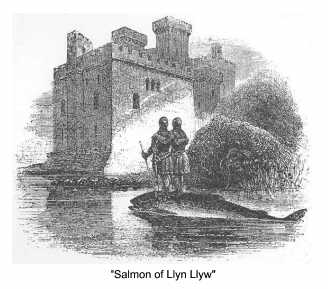 According to Jean Markdale, the fish, is ... "a sacred animal in Celtic mythology and probably of Nordic 'Hyperborean' origin .... The symbolism of the salmon is extremely important" (Markdale Icon 170) as it is highly adaptable, and able to find its source. The return to Source is the desired goal for those on the quest. Markdale recalls an early story wherein followers of the archaic Arthur, Kay and Bedwyr, climb onto a salmon's back to breach prison walls and free Mabon, a feminine, maternal image leading to the Celtic Mother Goddess (170-171). This suggests that it may not be possible to return to Source without incorporating the Feminine Divine. According to Jean Markdale, the fish, is ... "a sacred animal in Celtic mythology and probably of Nordic 'Hyperborean' origin .... The symbolism of the salmon is extremely important" (Markdale Icon 170) as it is highly adaptable, and able to find its source. The return to Source is the desired goal for those on the quest. Markdale recalls an early story wherein followers of the archaic Arthur, Kay and Bedwyr, climb onto a salmon's back to breach prison walls and free Mabon, a feminine, maternal image leading to the Celtic Mother Goddess (170-171). This suggests that it may not be possible to return to Source without incorporating the Feminine Divine.
Yet the era in which the Grail Legend is written is patriarchal. In the story, "... the King rode out alone to seek adventure under Love's compulsion and joying in her encouragement. Jousting, he was wounded by
a poisoned lance so seriously that he never recovered, your dear uncle — through the scrotum" (Eschenbach Parzival 244). The wound is also the case in Chretien, and: "In the Lancelot Grail the son of Joseph of Arimathea is wounded in the thigh by a black angel" (Jung, von Franz 90). The wound is reflected onto his kingdom, as the area around the castle becomes a Wasteland. The wound reminds me of Jacob who wrestles
with an angel and is wounded in the thigh, hip or genital area (Genesis 32:24-32). Jacob, the Patriarch, represents leadership and the unfailing promises of God passed down through chosen heirs. Since the leadership of the twelfth century strongly emphasized monotheism and patriarchy, might the wound of the Fisher King be that of the missing, misunderstood or unacknowledged feminine component? It is through the grace of one who encounters the Grail, a feminine symbol, that the Fisher King is healed and the Wasteland restored with life giving water. In the various stories it is Perceval or sometimes Galahad who heals the Fisher King after beholding the Grail (Matthews Quest 58-59). All of society is affected by the success of those who quest the Grail.
Another aspect of the popular legends is that they revolve around knights and chivalry. It would have been every young man's dream of that time to become a knight who serves the king. When Perceval sees his
first knight he exclaims "... here I see God Almighty in person ..." (Chretien 383). Perhaps his response reflects the thought of the time. "I've never before met a knight, said the boy, nor seen one, nor ever heard tell of one; but you are more beautiful than God! Would that I were like you, so shining and so well formed" (383). Francis of Assisi (1182-1226) also reflected admiration of the knights in his life and spirituality. This may be one of the reasons for the rapid spread of his Order. St. Bonaventure wrote of a vision Francis experienced which appears to have Grail legend themes.
God in his goodness showed him a vision of a magnificent palace full of armor, bearing Christ's cross as its coat-of-arms. He would let him see that the kindness he had done a poor knight for love of the supreme king would be repaid with an incomparable reward. And so when Francis asked to whom all this belonged, he was told from heaven, that it was all for him and his knights. (Bonaventure Omnibus 637)
Is Francis' question synonymous with the question of the Grail, "Whom does the Grail serve?" Francis used the language and thought of his time referring to Lady Poverty (Omnibus 1549f), the friars as knights, and Christ as the king (637). He expressed high esteem for the Virgin Mother Mary under the rules of chivalry in his poetry (Francis 135). Francis, the "Troubadour of the Great King" (Talbot Audio CD 1981) wrote many inspirational poems and hymns (Francis Omnibus 125-155). Having lived 26 years a Franciscan Brother and Priest, I believe that Francis was in touch with the essence of the Grail legend, namely the unveiling of the Self (or Christ) within. This is the drawing power which led me to the Franciscan Order and Vision Quest with the Lakota. The quest continues.
The theme of quest for the Divine appears to have had a powerful influence on the whole of society during the twelfth and thirteenth centuries. Emma Jung and Marie-Louise von Franz name artists, scientists,
the spiritual movements of the time as well as the secret societies, "... which take the Grail and Grail quest as subjects of meditation or of initiation ceremonies" (Legend 12-13). The year of preparation before vows in the Franciscan order is for a year and a day which appears as a theme in the Grail quest. Jung and von Franz state that the time in which the Grail legend flourished was unique and highly spirited.
This need 'to see the Holy Mystery unveiled' is characteristic of the great spiritual awakening of that time and its being manifested in such an impressive manner in every sphere of life. The intellectual movements of scholasticism (the works of secular literature, art and architecture, the founding of convents and monastic orders, the Crusades, chivalry and Minnedienst) are eloquent witnesses to the astonishing awakening of spirit — the intensity and many-sidedness of which has been exceeded in no other epoch. (Jung, von Franz 94-95)
Yet, the Grail, and "Naturally the Grail Castle cannot be localized in reality ....The origin of the legend ... also remained untraceable ..." (13), leading both East and West. [Emma Jung says], "according to one, the story can be traced back to pre-Christian, Western European and especially Celtic legends and myths. Other authorities derive it from Eastern Christian sources or else from Persia or pre-Christian cult practices, while a third view is that it originated in Christian ritual, especially in that of the Byzantine Mass" (13-14).
Loomis argues that the Grail legend moved "from Celtic Myth to Christian Symbols" (Celtic 7). Carl Jung appears to support him:
Further evidence of the pagan root of the vessel symbolism is the 'magic cauldron' of Celtic Mythology. Dagda, one of the benevolent gods of ancient Ireland, possesses such a cauldron, which supplies everybody with food according to his needs or merits. The Celtic god Bran likewise possesses a cauldron of renewal. It has even been suggested that the name Brons, one of the figures in the Grail Legend, is
derived from Bran. Alfred Nutt considers that Bran, lord of the cauldron, and Brons are steps in the transformation of the Celtic Peredur Saga into the quest of the Holy Grail. It would seem, therefore, that Grail motifs already existed in Celtic Mythology. (CW 6: 236-237n)
Herein lies a quest within the quest. While Christianity (patriarchy) dominates Western thought at the time, that which is dismissed (the goddess), forgotten or left behind returns in the guise of new names. Old heroes, gods and goddesses are resurrected, reshaped and melded into a fabric which outwardly displays Christian themes. Inwardly, however, lay the restoration of the old and hidden. Beyond the personal quest for the Grail is the unnoticed quest for the wholeness of society; the bringing together of the new and the old; the masculine and feminine. Jung speaks to this saying "the survival or unconscious revivification of the vessel symbol is indicative of a strengthening of the feminine principle in the masculine psychology of the time. Its [the Grail's] symbolization in an enigmatic image must be interpreted as a spiritualization of the eroticism aroused by the worship of woman" (Jung, CW 6: 237). This understanding plus an influx of information from many cultures is emphasized by Matthews. This is one of the mysteries of the Grail that sets it apart from the established Church, in the same way as its avowedly mystical properties transcend the form of Christian interpretation in which it was bound by the western romancers who put the stories in writing. Yet behind this lies much that is non-Christian in origin. The influx of ideas and culture from the east — through the agency of the crusaders and Troubadours who traveled with them, bringing back stories and songs that became outwardly Christianized — had a lasting effect on the shaping of the Grail legend. (Grail 26)
Given the constant exchange between cultures and the changes of time, "the quest for the Grail is never truly over" (Matthews 30). One is drawn to the quest, he says, whether willing or not. The quest has a power that will work through us until it brings the desired change in us (30). Eschenbach displays the Grail as beyond price or likened to the Scriptures "Pearl of Great Price" (Matthew 13:46). Secundile was told of the Grail, that there was nothing so splendid on earth and that it was in the care of a King Anfortas ... She sent him costly gifts ... more treasure than one could buy — you would never find it up for sale (Eschenbach Parzival 246).
The Grail takes on many forms, each inspired by the messenger or author. It can be the stone from heaven (Eschenbach Parzival 240), a cup, a ciborium, the chalice of the Last Supper (Tennyson Idylls 207), a bowl (Matthews Grail 72), or the dish (Matthews 11) referred to by Chretien. Jean Markdale states that the Grail is "a concept, a symbolic image that can assume all forms and which necessarily sits outside space and time (Sacred Icon 135). Jung states that:
To be effective, a symbol must be by its very nature unassailable. It must be the best possible expression of the prevailing world-view, an unsurpassed container of meaning: it must also be sufficiently remote form comprehension to resist all attempts of the critical intellect to break it down; and finally its aesthetic form must appeal so convincingly to our feelings that no argument can be raised against it on that score ...The Grail symbol clearly fulfilled these requirements, and to this fact it owed its vitality ... which is still not exhausted today, even though our age and our psychology strive unceasingly for its dissolution. (Jung, CW 6: 237)
Markdale states that the Grail carries an aura of a need for purity by those who handle, quest, or see it (Icon 135-136). Such is also true of the Sacred Pipe, as one is encouraged to have a pure mind and a good heart. According to the Myth, White Buffalo Calf Woman who gave the Sacred Pipe to the Lakota was sexually sought after by one of the warriors. He was turned into a heap of bones. Is she the Repanse de Schoye of the Lakota? Is she the Mother Goddess come to rescue the Lakota at the time when a white patriarchal society was about to over-take their land? Is the Wasteland the disappearance of the Buffalo, destruction of the land and enforcement to Reservation living? Could it be that the Grail legend is remade in the Lakota culture through the Legend of White Buffalo Calf Woman? Whether handled by White Buffalo Calf Woman or Repanse de Schoye the Grail holds a great sense of wonder that leads to an awakening during difficult times.
Matthews says the Grail symbol goes back to the circle and therefore to seasonal time and womanhood, in short, the Goddess. He believes the Grail recalls us to memory of the reclining woman of Malta whose womb the dead enter as they return to the earth. It refers us to the great domes of the earth and sky which house the universe. All of which reflects the shape of the bowl, the cup, chalice or Grail (Grail 8-9). The experience of the mystery of the Grail quest enables people and cultures to transcend the trappings of the new by embracing what seems forgotten, or by mixing in the shadows. The new is honed and reshaped by the spiritual understanding those on the quest embody. As Matthews states, "he who achieves the Grail is the one who succeeds in healing both a psychospiritual wound and the death-struck kingdom of the Grail. The cup is a vessel of compassion, signifying wholeness" (Matthews Grail 30).
One is reminded of the Mendicant Orders who care for the poor and outcast. Compassion unites opposites; opening the heart a feminine aspect rushes in, brings balance and stirs the flow of creativity. Jung states that, "Life, being an energetic process, needs the opposites, for without opposition there is, as we know, no energy ....The tension of opposites that makes energy possible is a universal law ..." (Jung, CW 11: 197). There is a spiritual tension created in the Grail stories as reflected by the Wasteland, the Fisher King's wound and because some see the Grail while others do not. The Grail Legends seem to manifest a strong call to faith and action. It is not surprising that the period following the Grail era ushers in a great energy which expresses the arts and sciences. This energy appears to occur through the gifts of zeal and grace.
Since the appearance of the Grail is "454 years after Pentecost" (Loomis Celtic 169), Loomis links the Grail legend with Pentecost; as grace of the Holy Spirit (182-184). He refers to the Grail when he says, "the fountain is the sweet rain, the sweet word of the Gospel, in which the heart of the truly repentant sinner finds such great sweetness that the more he tastes it, so much the more does he desire it." (183). The
Grail, he goes on, is a symbol of grace, of God's love for humanity. For this reason the themes of vows, purity and self-denial run throughout the Arthurian legends. "... I warn you plain, he that is not clean of his sins, he shall not see the mysteries of our Lord Jesus Christ" (Loomis Quest del Saint Graal 173). Eschenbach emphasizes the life of virtue as he states that "those knights who are resolved on serving the Grail must forgo woman's love" (Parzival 251). Perhaps this suggests that they are to be self contained through the guidance of Spirit.
Matthews emphasizes that the focus of the quest is to become spiritual creatures (Grail 30). Perceval's refusal to ask the question is a refusal to become involved in the life-giving force of the Grail. The Grail as the container of compassion invites one to service of self, of the king and of his kingdom (Matthews 30). The refusal to ask the question, Matthews says, is to expel oneself from Eden; from Paradise. Like the Grail Quest, the whole purpose of Vision Quest is to come to know the gift or service one brings to the world. If one encounters the Grail one becomes as a bridge between two worlds, a communication by means of service through Spirit. The "... object (the Grail or Pipe) becomes a vehicle of worship, like the Torah, the Host, or the Black Stone; or it loses its separate identity, and a kind of exchange takes place, as in St. Paul's 'I live no longer, Christ lives in me', or in the alchemist's contemplation of the lapis which causes him to become one with it" (31).
Black Elk explains that the Sacred Pipe holds the prayers and powers of the entire universe (Sacred 21n). Joseph Epes Brown quotes an Osage song which equates the stem and bowl to the human body; as both container and offering (21n). While on the reservation I heard elders say that with practice one becomes the Sacred Pipe, for one holds and offers the prayers of the universe through their bodies. This is what it means to participate in the Great Mystery. This is what it means to Quest the Grail.
Works Cited:
- Bonaventure. St. Francis of Assisi: Writings and Early Biographies. Ed. Marion A. Habig. Trans. Raphael Brown, Placid Herman. Chicago: Franciscan Herald Press, 1973.
- Brown, Joseph Epes. ed. The Sacred Pipe: Black Elk's Account of the Seven Rites of the Oglala Sioux. Norman: University of Oklahoma, 1989.
- Eschenbach, Wolfram von. Parzival. Trans. A. T. Hatto. New York: Penguin, 1980.
- Francis of Assisi. St. Francis of Assisi: Writings and Early Biographies. Ed. Marion A. Habig. Trans. Rapheal Brown, Placid Herman. Chicago: Franciscan Herald Press, 1973.
- Jung, Carl Gustav. The Collected Works of C. G. Jung. Trans. R. F. C. Hull. Vol. 6. Princeton: Princeton U P, 1971
- Jung, Carl Gustav. The Collected Works of C. G. Jung. Trans. R. F. C. Hull. Vol. 9ii. Princeton: Princeton University Press, 1978.
- Jung, Carl Gustav. The Collected Works of C. G. Jung. Trans. R. F. C. Hull. Vol. 11. Princeton: Princeton University Press, 1969.
- Jung, Carl Gustav. The Collected Works of C. G. Jung. Trans. R. F. C. Hull. Vol. 18. Princeton: Princeton University Press, 1980.
- Jung, Emma and Marie-Louise von Franz. The Grail Legend. 2nd ed. Boston: Sigo Press, 1980.
- Loomis, Roger Sherman. The Grail: From Celtic Myth to Christian Symbol. New Jersey: Princeton, 1991
- Matthews, John. The Grail: Quest for the Eternal. London: Thames and Hudson, 1981.
- Markdale, Jean. The Grail: The Celtic Origins of the Sacred Icon. Trans. Jon Graham. Vermont:Inner Traditions International, 1999.
- Smith, Evans Lansing. Sacred Mysteries: Myths about Couples in Quest. California: Blue Dolphin, 2003.
- Stolzman, William. The Pipe and Christ: A Christian Sioux Dialogue. 7th ed. Chamberlain: Tipi, 2002.
- Talbot, John Michael, Troubadour of the Great King. Audio CD, 1981.
- Tennyson, Alfred Lord. Idylls of the King. Ed. J. M. Gray. London: Penguin, 1996.
- Troyes, Chretien de. Arthurian Romances. New York: Penguin, 1991.
 Gary German, an active Catholic priest for 12 years, worked with African American, Latino, and Native American populations. In 2004 he became an Interfaith Hospice Chaplain in the East Bay of Northern California an area with more than 143 global cultures. Gary is presently a student at Pacifica Graduate Institute, of Carpinteria CA, enrolled in the Mythology with Emphasis in Depth Psychology--Masters/Doctoral Program. Gary German, an active Catholic priest for 12 years, worked with African American, Latino, and Native American populations. In 2004 he became an Interfaith Hospice Chaplain in the East Bay of Northern California an area with more than 143 global cultures. Gary is presently a student at Pacifica Graduate Institute, of Carpinteria CA, enrolled in the Mythology with Emphasis in Depth Psychology--Masters/Doctoral Program.
Return to Passages Menu
Subscribe to the Passages e-zine
|
